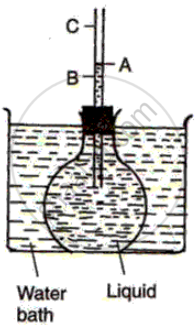Advertisements
Advertisements
Question
Solution
Fill a round bottom flask with a coloured liquid up to the brim. Fit it with a one holed cork and pass a narrow glass tube through it. Mark the level of the liquid in the glass tube as A. Place the flask in a water bath and heat the bath. You will see that the level of liquid of water starts falling to level Band then it rises to level C. In this, AC is the apparent expansion and is due to expansion of the flask due to heating which provides more space for the liquid. Hence the level of liquid drops. As soon as the liquid also starts getting heated up, it expands and the level of liquid rises. BC is the real expansion. So the actual expansion of the water is the sum of AC and AB.

APPEARS IN
RELATED QUESTIONS
What do you understand by thermal expansion of a substance?
State three factors on which depend the linear expansion of a metal rod on heating.
Two identical rods of copper are heated to different temperatures — one by 5°C and the other by 10°C. Which rod will expand more?
An empty glass bottle is fitted with a narrow tube at its mouth. The open end of the tube is kept in a beaker containing water. When the bottle is heated, bubbles of air are seen escaping into water. Explain the reason.
What is thermal expansion?
What difference do you think heating the solid will make in their molecules?
If you heat a circular disk with a hole, what change do you expect in the diameter of the hole? Remember that the effect of heating increases the separation between any pair of particles.
How solids are expanded on heating?
